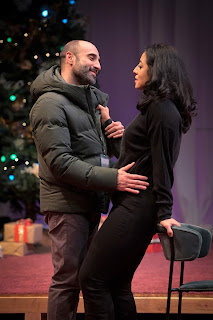 |
| From left: Ronnette (Melinda Campero), Chiffon (Becky Alex) and Crystal (Kylie Abucay) sing. (Tracy Martin photo) |
“Little Shop of Horrors” is far from great theater,
but it’s usually great fun.
Directed by Tyler Christie, Hillbarn Theatre’s
production isn’t always great fun, but it has its strengths. Chief among them
are the three women who serve as a sassy Greek chorus.
Kylie Abucay as Crystal, Becky Alex as Chiffon and
Melinda Campero as Ronnette are always fun to watch and hear as they sing,
dance and comment throughout the show. Randy O’Hara did the choreography.
With a book and lyrics by Howard Ashman and music by
Alan Menken, “Little Shop” is set in a rundown florist shop in Skid Row. Owned
by Mr. Mushnik (Jesse Caldwell), it’s about to close down for lack of business.
 |
| Seymour (Phil Wong) holds Audrey II. (Mark Kitaoka photo) |
However, Audrey (Jocelyn Pickett), one of his two
employees, says that the other employee, Seymour (Phil Wong), has a “strange
and interesting plant.”
Mr. Mushnik places it in the front window, and sure
enough, business starts to pick up, and Seymour gains a measure of fame.
There’s just one hitch. It seems that the plant,
named Audrey II, has a finicky appetite, thriving only on human blood. At first
a few pin pricks from Seymour are enough for it to grow. However, its appetite
becomes more voracious, leading to some nefarious deeds.
Although the nerdy Seymour is enamored with Audrey,
she’s in an abusive relationship with a sadistic dentist, Orin (Sam Nachison,
who plays several other roles, too). She stays with him because she doesn’t
think she deserves anyone better.
One of the unique aspects of this production, at
least in comparison with the several others that have been seen around the Bay
Area in recent years, is that Audrey II isn’t just a prop that grows and grows
and that is voiced by a man who insists, “Feed me.”
 |
| Jad Bernardo portrays Audrey II. (Mark Kitaoka photo) |
Instead, the plant is seen as a man in high drag, Jad
Bernardo. The device doesn’t always work, though, especially since the actor
appears so soon in the production.
Some of the songs and lines are humorous, especially
when they reflect the characters’ views of what constitutes something better for
them. For example, when singing “Somewhere That’s Green,” Audrey longs for a
nicer place to live, but “nothing fancy like Levittown.”
Later, Seymour says he’d like to take her to a fancy
dinner at somewhere like Howard Johnson’s.
Design elements are mostly good, especially the
costumes by Y. Sharon Peng, who also designed the hair and makeup.
The two-level, appropriately dingy set is by Kuo-Hao
Lo, with lighting by Pamila Gray and sound by Brandie Larkin.
Music director is Joe Murphy, who plays drums in the
five-person band.
Running about two hours with an intermission,
“Little Shop of Horrors” will continue through Feb. 9 at Hillbarn Theatre, 1285
E. Hillsdale Blvd., Foster City.


